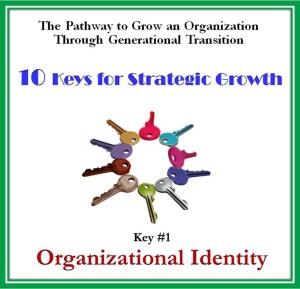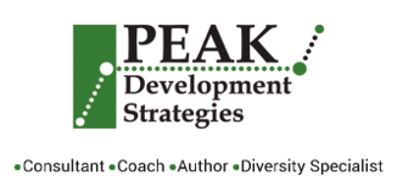The generations of men run on in the tide of time, but leave their destined lineaments permanent forever and ever. ~ William Blake
 Our first step in the “10 Keys for Strategic Growth” Audit is to define your Organizational Identity. It exists, but perhaps not in the detail or definition it requires for sustainable success. If there are Values, Purpose, Vision, and Mission Statements that already exist, have them handy so that they can be modified and/or tested with regard to generational diversity and future growth.
Our first step in the “10 Keys for Strategic Growth” Audit is to define your Organizational Identity. It exists, but perhaps not in the detail or definition it requires for sustainable success. If there are Values, Purpose, Vision, and Mission Statements that already exist, have them handy so that they can be modified and/or tested with regard to generational diversity and future growth.
The goal for this book is to develop your Organizational Identity as a solid bedrock for your organization to stand on. It also will engage your passion as well as your staff members’ passions and buy-in. If you already have these statements in place, it is important to do some generational testing for their sustainability and relevance to younger generations in and entering into the market.
Values – are words that describe who we are and how we go about doing business. This is both by the brand of the organization as well as the individuals within the organization. Even if the Organizational Value Statements have not been defined on paper, they do exist. They play an important role in how organizations confront issues.
Examples of Values are:
- Dependable
- Reliable
- Innovative
- Honest
Purpose Statement – is the first step in defining your organization’s brand and what you are promising to your customer. It is not as broad as the Mission Statement; it has more of a focus on your operational plan.
Here is ING’s Purpose Statement:
“Empowering people to stay a step ahead in life and in business”
Vision Statement – most successful businesses have a vision that inspires, enables, and guides the business toward growth. Your vision of the organization may be limited to just your generational view. Acknowledge this and create a best thinking/consensus building environment where your teams can openly share their visions and ideas without fear of contempt or criticism.
Here is Special Olympics’ Vision Statement:
“To transform communities by inspiring people throughout the world to open their minds, accept and include people with intellectual disabilities and thereby anyone who is perceived as different.”
Long-Term Goals – need to be S.M.A.R.T. – what does it look like 10, 20, 30 years from now when the ownership of this organization changes hands?
Specific – the details of what is to be accomplished in a clear and simple way.
Measurable – the goal must be quantifiable.
Attainable – it must be reachable considering ability, talent, and resources.
Relevant – does this goal match up to what the organization desires to accomplish?
Timely – there is a deadline to completing the goal.
Mission Statement – helps you define your identity and strategy as an organization. It will also answer the question “Why are we in business?” The statement also defines “What you do and why do you do it?” Lastly, it answers “What value are you bringing to your customers?” This statement should be short and succinct, something that the entire organization can memorize.
Here is Starbuck’s Mission Statement:
“Our Coffee. It has always been, and will always be, about quality. We’re passionate about ethically sourcing the finest coffee beans, roasting them with great care, and improving the lives of people who grow them. We care deeply about all of this; our work is never done.”

Recent Comments